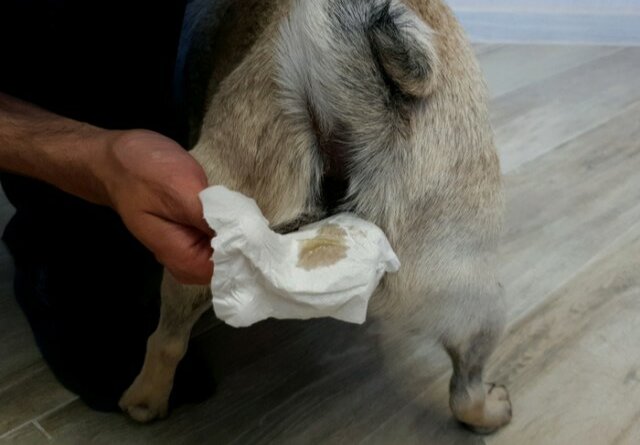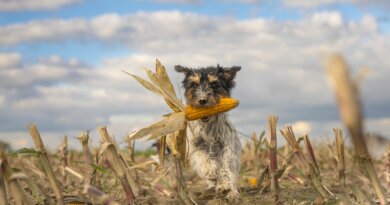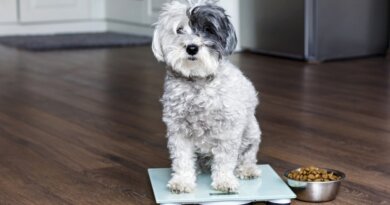Dog Scooting: Why is My Dog Dragging Its Butt and How to Stop It
Do you ever find how funny or cute it is to see your dog rubbing butt on the carpet? Some dog owners find themselves feeling ashamed for their Fido’s weird behavior.
Dog scooting is an embarrassing thing that your dog could do in front of your guests, but if you find them doing it excessively and with discomfort, then there is something wrong with your dog’s itchy bum.
While some would say, it’s a behavioral problem or a kind of trick that dogs do to get their owner’s attention, that might not always be the case.
In this article, learn what dog scooting butt is, why dogs rub their butt on the ground, and what you can do to stop it. It’s not always a severe case, but it pays to be extra careful.
Scooting is often described when a dog drags its butt along the ground in a seated position. According to a vet in the Animal Acupuncture in NYC, it’s the dog’s way of saying that they are experiencing discomfort.
It could indicate a mild concern or a serious underlying medical issue. Either way, it’s a clear sign that your dog is not feeling well “back there.”
Why Does Dog Scooting Happen?
Is your dog dragging its butt again?
It’s widespread for a dog to scoot around on its butt. They’re probably just doing a simple itch in that area.
By knowing what causes dog scooting, you will understand your puppy better and provide an immediate solution to whatever is causing it.
Here are the common causes you should know about:
Anal Gland Issues
These are two tiny sacs located at each side of your dog’s rear end. It carries a foul-smelling residue expressed whenever they poop.
This liquid is also considered as the dog’s pooping mark. It releases a signal that signifies their “territory” to other dogs.
In typical cases, a dog’s bowel system sends a trigger to the anal sacs and allows them to empty. However, if it’s not working correctly, that’s when problems arise, and your dog starts dragging its butt.
Since dogs’ anal sacs are delicate organs in their body, they are also susceptible to more anal gland problems. For instance, the following conditions could occur:
- Clogging
- Inflammation
- Infection
- Trauma or Injury
When this happens, don’t panic. An impacted anal gland can occur from time to time. Check what each condition of the anal sacs looks like and know what you can do about it.
Clogging of Anal Sacs
The fluid may build up and solidify. When this happens, it will hinder the release of any liquid until the anal glands become inflamed.
An evident sign that your dog’s anal glands are clogged is that it appears enlarged and swollen. In worse cases, these sacs will have a bloody discharge.
When this happens, you can either release the liquid yourself or apply an ointment or warm compress in the meantime.
Infected or Inflamed Anal Glands
As the fluid builds up inside the sacs, it becomes thick and paste-like instead of its usual liquid form. This condition can become very uncomfortable for your dog.
Bacteria from feces are usually flushed out with the fluid from the anal sacs. The bacteria tend to pile up with an impacted sac and cause infection.
Trauma to the Rear End
A groomer may have released the fluids from the sac even when they’re not supposed to. You might have also drained the anal glands of your pup too harshly.
The sacs are delicate and sensitive organs in your dog’s body, and rough manual extraction could cause damaged tissues, inflammation, and pain.
If you have also repeatedly expressed the fluids from the anal glands, it can destroy the necessary muscles that help them release the liquid.
ALSO READ: 12 Ways to Prevent and Treat Dog’s Anal Glands
Dog Scooting Allergies: Specifically Food
Just like any allergy, your dogs can experience the same symptoms in their rear ends. It can result in itchiness, irritation, and possible pain.
Dog scooting is one way to alleviate the itch and irritation, but it can attract bacteria which later causes inflammation in their bottoms.
Diet also contributes to your dog’s bowel movement. Having less fiber can affect their stools and anal sacs from functioning correctly.
Skin Irritation Due to Grooming
All dogs need to be groomed, whether you are visiting a professional groomer or doing the Grooming yourself.
It may be inevitable for your dog to experience a scratch, especially if they are a very active dog breed. Skin irritation under the tail or in your dog’s rear can happen from grooming products that your dog doesn’t tolerate.
You may see that irritation is evident when dog scooting happens right after grooming. They will also itch all over the body or lick the affected areas.
Intestinal Parasites
Worms and parasites are possible causes of dog scooting butt. The most common type is tapeworms which your dog could ingest by contaminated food or water.
Common symptoms of an infestation are an itchy dog butt, scooting, and small eggs of worms in the anus area. You will also see some of the worms in dogs’ poop.
Injuries to the Bottom
What are other reasons why do dogs rub their butt on the ground? It could be due to injuries.
Any sudden blow or trauma to the rear end causes pain and discomfort. Dogs scoot to lessen the pain.
Another cause of injuries is when you or a groomer attempt to shave their hairy bottom and end up putting a few scratches. Your dog dragging butt is just its way of comforting the wound.
When this happens, make sure to treat the area immediately with an ointment or warm compress. Prevent dog scooting as it may further infect the area.
Neoplasia
There’s still dog scooting but no worms. What’s wrong? It could be a more severe problem than you thought.
Neoplasia refers to the abnormal growth of cells in the body. It can occur in any part, including under the tail or near the rear end.
Another term for neoplasia is a tumor, which can either be benign or malignant. The symptoms are abnormal swelling, bleeding in bodily openings, and sores.
It affects their bottom and leads to dog scooting to alleviate any pain. This should not be confused with anal gland issues and should be checked by your vet right away.
Poop Stuck in Dog’s Butt
This may be a dreadful situation for most dog owners, but having hardened poop stuck in the hair or anus of your pooch could happen.
As the poop sticks in your dog’s behind, it will make them feel annoyed or irritated. Bacteria from the poop will also cause an itchy dog butt if left unnoticed for a long time.
Poop stuck usually happens to the dog butt, especially for breeds with long coats. Best to keep the rear area trimmed for hygienic purposes.
It’s revolting to pick hardened stool sticking in your dog’s butt manually, but you need to do it anyway to avoid infection and your dog scooting even more.
Is Dog Scooting Serious?
Well, it depends. Have you observed how humans scratch different parts of their body whenever it itches? That’s the same with dogs.
Scooting happens with a dog itchy bum. You can tell by how they scoot on the carpet or lick their bottom from time to time.
If dog scooting has frequently been happening for more than two days with signs of discomfort, that’s a warning sign that there could be a severe condition underlying the situation.
In this case, you should check your dog’s rear end. Common reasons dogs rub their butt on the ground are their anal glands, worms, or infection.
You should see if the anal glands are complete or whether worms are present in the anus. If this is not the case, try to touch the area of your dog’s bottom gently.
Look out for any release of pus or blood discharge. You can also check for unusual lumps. It indicates potential tumors, which could be the worst cause for dog dragging butt.
When this happens, it’s best to rush your dog to the vet to have him checked. You can assure what exactly is the reason for dog scooting and what you can do as a solution.
Does Scooting Mean Your Dog Has to Poop?
It’s a possibility that dog scooting may be a sign that your puppy is telling you that he needs a potty break.
But in most cases, it’s quite the contrary. Dog scooting after pooping is a more common scenario.
It’s probably because there are still fecal matters stuck in its fur in the rear end. Another case is that worms might be present in the dog’s poop and could still be attached to its anus.
Either way, you need to check the dog’s butt and wash it with warm water and gentle soap.
Do Dogs Scoot When Constipated?
If dog scooting occurs, but their glands are empty, constipation could be one of the causes. Your puppy will feel restless and will try to pass the feces.
You may see them circling excessively, squatting, or rubbing their butt on the carpet. They attempt to release their poop or alleviate constipation is causing.
This condition may also be shared among pups, especially with their sensitive stomachs. You may see your puppy dragging butt and crying out in severe cases.
You may want to give quality dog food high in fiber when this happens. If the situation is worse, you can consult with your vet and ask for suitable medication.
What to Do When Your Dog Keeps Dragging Its Butt
You might find your dog scooting its butt from time to time. However, you shouldn’t be worried enough to rush him immediately to the vet.
Dog scooting is expected behavior when your pup has an itch. You would only need to worry when the dog dragging butt behavior is more persistent with signs of pain or irritation.
Whenever your dog scoot, you can check the area first. See if the anal glands are swelling up or any redness near the anus.
Give your dog a gentle wash, especially in their rear area, with shampoo and a soft cloth. You can also add a warm compress to lessen the pain.
When to See a Vet
The best time to consult your vet is when your dog is dragging its butt more than once a day, and this behavior persists for more than a day or two.
If you don’t want to wait that long, you can check your dog’s butt and look for any signs of trauma or inflammation in their anal glands.
Another warning sign is seeing them in pain as they drag their butts. Some dogs would even scratch or lick that part more aggressively than usual.
Once you consult your vet, the first thing they would probably do is conduct a rectal exam to see how the area looks like. They would do fecal tests to check any intestinal parasites in other cases.
If anal glands problems cause dog scooting, your vet will try to express the glands or provide ointment for the inflammation. A new diet or deworming medication is prescribed for parasite issues to stop dog scooting butt.
In chronic cases, the vet recommends removing the anal glands through surgical means. However, this would require a more severe issue with another type of specialist.
How to Prevent Dog Scooting its Butt in the First Place
You don’t want to be dealing with dog scooting over and over again. Fortunately, there are many ways to avoid it from happening in the first place.
An itchy dog butt has many remedies as long as you know what’s causing it. Learn what you can do:
Provide a High-Quality Diet
Make sure your dog has a well-balanced meal full of fiber and nutrients.
When there’s more fiber to their diet, it will firm the stool and aid in better bowel movement. It also prevents the risk of anal problems, which is the common cause of dog scooting.
Determine Allergies
Know what food or medication your pup may be allergic to. That way, you can avoid them at all costs.
Allergies don’t only limit to their food and diet. It may also refer to their shampoo, soap, or perfume. Hence, it’s essential to use those with organic ingredients.
You may also want to ask your vet for recommendations for these products. That way, you wouldn’t have to worry about your dog scooting because of a poorly-formulated solution.
While some allergies don’t have severe reactions, a dog scooting its butt may be a mild symptom to look out for (and possibly avoid).
Consult Your Vet About Supplements
Adding supplements to your dog’s diet can aid in their digestion. This helps your dog to prevent any intestinal issues or anal gland problems.
Fortunately, plenty of fiber supplements is available in the market for your dog to maintain its digestive health and avoid dog scooting.
Check the Rear End More Often
The dog butt is one of the least noticed parts of a canine. Despite this, it is yet a sensitive area that needs to be checked more often.
When your dog scoot, that usually means there is an itch in its rear end. It may also be a cry of help, wanting you to check out that itchy dog butt.
See if there is anything unusual in your dog’s butt. It’s usually emphasized in swelling or redness.
You might see pus discharge, bleeding, or unusual lumps in worse cases. If you identify this, it’s best to consult your vet immediately.
Keep Your Surroundings Clean
Since dog scooting may be caused by intestinal parasites, maintain your surroundings at home and outdoors clean.
It would help if you also kept an eye on what they eat. Give them fresh food and water to prevent the ingestion of any parasite inside the stomach.
Don’t Express the Anal Glands Too Often.
Don’t drain the anal glands, especially if there’s no problem in the first place. Impacted anal glands can cause inflammation and infection, resulting in the dog dragging its butt.
Ask a vet to express the anal sacs manually if you’re uncomfortable with doing it yourself. You can also ask your vet to teach you how and when is the best time to do so.
ALSO READ: How to Drain Anal Glands on Dogs
Dog Scooting: Conclusion
When you see your dog scooting butt, it may appear as normal behavior. As it persists, this condition could be dangerous to your dog’s health if left untreated.
There are many reasons dogs rub their butt on the ground, but it signifies that your puppy is in pain or discomfort. Do any measure necessary to treat your dog dragging butt when this happens.
Fortunately, there are plenty of ways to alleviate the itch or pain and stop dog scooting if you feel squeamish treating dog butt. It is best to visit a vet and have your puppy checked and treated by experts.
The post Dog Scooting: Why is My Dog Dragging Its Butt and How to Stop It appeared first on Top Dog Tips.








